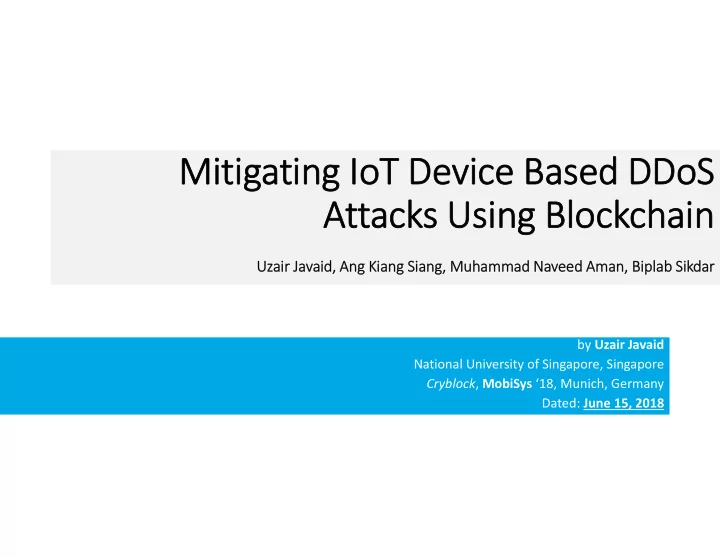

Mitigating IoT Device Based DDoS Attacks Using Blockchain Uzair Javaid, Ang Kiang Siang, Muhammad Naveed Aman, Biplab Sikdar by Uzair Javaid National University of Singapore, Singapore Cryblock , MobiSys ‘18, Munich, Germany Dated: June 15, 2018
Outline Introduction Internet of Things IoT Denial of Service DoS /Distributed DoS Attacks Blockchain Mitigation of DoS/DDoS Attacks Common Approach The IoT‐Ethereum Model Evaluation Central v/s Decentralized Trusted Devices List Defense against DDoS Attacks Conclusion
Introduction Internet of Things IoT Devices interacting with each other through Internet Resource constrained and easy to attack due to cheap security architecture
continued… Denial of Service DoS /Distributed DoS Attacks Device uploading extremely large quantity of data to crash server(s) DoS Devices uploading extremely large quantity of data to crash server(s) DDoS Enabled primarily through IoT devices because of weak security protocols
continued… Blockchain A digital ledger with chronological blocks Decentralized architecture Common consensus agreements Smart contracts
Mitigation of DoS/DDoS Attacks Common approach No trusted list of IoT devices Bandwidth limit of each device is usually not limited Reactive measures rather than proactive
continued… IoT‐Ethereum Model Trusted list of IoT devices Bandwidth constrained (static) Proactive protocol rather than reactive
continued… IoT‐Ethereum architecture
continued… System Operation
Evaluation Centralized v/s Decentralized Single point of failure Distributed control (consensus) Shared resources
continued… Trusted Devices List Registering a device first before it can upload data Blocking rogue devices from interacting with the system
continued… Defense against DDoS Attacks Authenticating devices when uploading data Keep devices within good bandwidth limit
Conclusion IoT and Blockchain Platform Decentralized Trust‐free system operation Defense against DDoS attacks and blocking rogue deivces
Discussion Scalability issues Advance performance evaluation and security analyses Protection for IoT devices from inter‐DDoS attacks Dynamic resource allocation Geo‐tagging IoT devices
Q u e s t i o n s ?
Recommend
More recommend